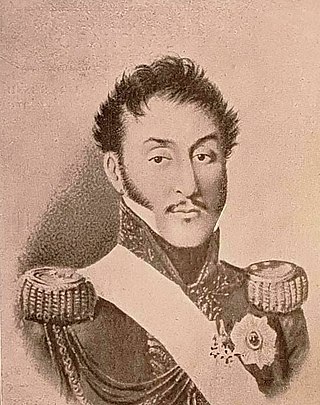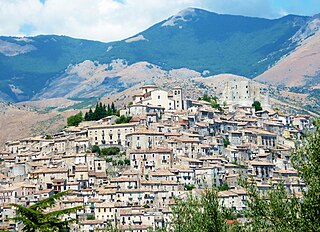
The War of the Third Coalition was a European conflict lasting from 1805 to 1806 and was the first conflict of the Napoleonic Wars. During the war, France and its client states under Napoleon I and its ally Spain opposed an alliance, the Third Coalition, which was made up of the United Kingdom, the Austrian Empire, the Russian Empire, Naples, Sicily, and Sweden. Prussia remained neutral during the war.

The Neapolitan War, also known as the Austro-Neapolitan War, was a conflict between the Napoleonic Kingdom of Naples and the Austrian Empire. It started on 15 March 1815, when King Joachim Murat declared war on Austria, and ended on 20 May 1815, with the signing of the Treaty of Casalanza. The war occurred during the Hundred Days between Napoleon's return from exile and before he left Paris to be decisively defeated at the Battle of Waterloo. The war was triggered by a pro-Napoleon uprising in Naples and ended with a decisive Austrian victory at the Battle of Tolentino, after which Bourbon monarch Ferdinand IV was reinstated as King of Naples and Sicily. However, the intervention by Austria caused resentment in Italy, which further spurred on the drive towards Italian unification.

The Battle of Tolentino was fought from 2–3 May 1815 near Tolentino, Kingdom of Naples in what is now Marche, Italy: it was the decisive battle in the Neapolitan War, fought by the Napoleonic King of Naples Joachim Murat to keep the throne after the Congress of Vienna. The battle occurred during the Hundred Days following Napoleon's return from exile and, like the Battle of Waterloo, resulted in a decisive victory for the Seventh Coalition, leading to the restoration of the previous Bourbon king, Ferdinand I.

The Battle of the Panaro was a victory for King Joachim Murat's Neapolitan forces over a smaller Austrian force under Frederick Bianchi on 3 April 1815 early in the Neapolitan War. This defeat on the banks on the Panaro River, just south of Modena forced the Austrians to retreat behind the Po River.
The Battle of Carpi took place during the Neapolitan War between a brigade of Neapolitan soldiers under the command of Guglielmo Pepe and an Austrian force under the command of Baron Frimont. The battle took place in the town of Carpi and resulted in an Austrian victory, with the Neapolitans being driven from the town.

The Battle of Casaglia was a part of the Neapolitan War. An Austrian force under the command of Johann Friedrich von Mohr engaged a Neapolitan force under their commander, Joachim Murat. The battle took place around the village of Casaglia, seven miles northwest of Ferrara, and resulted in the Austrians recapturing the village from Murat.
The Battle of Occhiobello was fought on 8 April – 9 April 1815 and was the turning point of the Neapolitan War. Joachim Murat, King of Naples was repulsed by an Austrian force under the command of Johann Frimont whilst trying to cross the bridge over the Po River at Occhiobello. Following the battle, the Austrians would not lose an engagement for the remainder of the war.
The Battle of Ronco took place during the Neapolitan War on 21 April 1815 in the village of Ronco, just south of Forlì. The main Neapolitan army, retreating following the disaster at the Battle of Occhiobello, was being pursued by an Austrian corps under the command of Adam Albert von Neipperg. The Neapolitans, commanded by their king, Joachim Murat, turned to check the Austrians at the Ronco River. The Neapolitans rear guard was defeated by a smaller advanced Austrian force, compelling Murat to retreat further south to the Savio River. The Austrians suffered light casualties, whereas nearly 1,000 Neapolitans were killed or wounded and more deserted Murat altogether.

The Battle of Cesenatico was a minor battle in the Neapolitan War that took place on 23 April 1815 in the town of Cesenatico on Adriatic coast.

The Battle of Pesaro was a minor battle in the Neapolitan War that took place on 28 April 1815 in the town of Pesaro.

Adam Albert, Count von Neipperg was an Austrian general and statesman. He was the son of a diplomat famous for inventing a letter-copying machine, and the grandson of Count Wilhelm Reinhard von Neipperg. His second wife, Empress Marie-Louise, was the widow of Napoleon and a daughter of Francis II, the last Holy Roman Emperor and founding Emperor of the Austrian Empire.

Vinzenz Ferrerius Friedrich Freiherr von Bianchi, Duke of Casalanza, was an Austrian Feldmarschallleutnant who notably served during the Napoleonic Wars.

The Battle of Castel di Sangro was a minor battle in the Neapolitan War that took place on 13 May 1815 in the town of Castel di Sangro in central Italy. The battle resulted in the Neapolitan force being routed.

The Battle of San Germano was the final battle in the Neapolitan War between an Austrian force commanded by Laval Nugent von Westmeath and the King of Naples, Joachim Murat. The battle started on 15 May 1815 and ended on 17 May, after the remaining Neapolitan force was routed at Mignano.

The siege of Ancona took place during the Neapolitan War. It took place beginning on 5 May 1815 and persisted until 30 May 1815. The battle took place mere days after the Battle of Tolentino on 3 May 1815.
The Treaty of Casalanza, which ended the Neapolitan War, was signed on 20 May 1815 between the Napoleonic Kingdom of Naples on the one hand and the Austrian Empire, as well as the Great Britain, on the other. The signature occurred in a patrician villa, owned by the Lanza family, in what is now the commune of Pastorano, Campania, southern Italy.

The Battle of Campo Tenese saw two divisions of the Imperial French Army of Naples led by Jean Reynier attack the left wing of the Royal Neapolitan Army under Roger de Damas. Though the defenders were protected by field fortifications, a French frontal attack combined with a turning movement rapidly overran the position and routed the Neapolitans with heavy losses. The action occurred at Campotenese, a little mountain village in the municipality of Morano Calabro in the north of Calabria. The battle was fought during the War of the Third Coalition, part of the Napoleonic Wars.

The Royal Sardinian Navy was the naval force of the Kingdom of Sardinia. The fleet was created in 1720 when the Duke of Savoy, Victor Amadeus II, became the King of Sardinia. Victor Amadeus had acquired the vessels be used to establish the fleet while he was still the King of Sicily in 1713. The Sardinian Navy saw action in a number of conflicts, including the French Revolutionary Wars and the Napoleonic Wars from the 1790s to 1810s, limited actions against the Barbary Coast such as the Battle of Tripoli in 1825, and the Second Italian War of Independence in 1859. The last war was a major step toward Italian unification, which led to the creation of a united Italian state in 1861. During the fighting in 1860, the Royal Navy of the Two Sicilies either defected or surrender and was merged into the Sardinian Navy, resulting in the creation of the Regia Marina, which itself became the Marina Militare, the modern Italian navy, in 1946.

The Army of the Kingdom of Naples was the land force of the Kingdom of Naples. It was in service from 1806 to 1815, reborn from the Army of the Two Sicilies after the French invasion of Naples. It served alongside Napoleon’s Grande Armée in various campaigns of the Napoleonic Wars, until its final demise in the Neapolitan War.

The Italian campaign of 1813–1814 was the series of military operations of the War of the Sixth Coalition, mainly in Northern Italy, that pitted the French Empire and the Kingdom of Italy against Coalition forces led by Austria and Britain. It represented the last stage of the so-called "French period", beginning with the Italian campaign of 1796–1797, in which a French and an Austrian army confronted each other for control of the Italian peninsula. The Austro-Neapolitan War of 1815 was essentially a clash between only Italians and Austrians.














